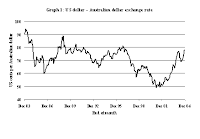
Listed below is a table of historical exchange rates relative to the U.S. Dollar, at present the most widely traded currency in the world.[1] An exchange rate represents the value of one currency in another. An exchange rate between two currencies fluctuates over time. The value of a currency relative to a third currency may be obtained by dividing one U.S. dollar rate by another. For example if there are ¥120 to the dollar and €1.2 to the dollar then the number of yen per euro is 120/1.2 = 100.
The magnitude of the numbers in the list do not indicate, by themselves, the strength or weakness of a particular currency. For example the U.S. Dollar could be rebased tomorrow so that 1 new dollar was worth 100 old dollars. Then all the numbers in the table would be multiplied by one hundred, but it does not mean all the world's currencies just got weaker. However it is useful to look at the variation over time of a particular exchange rate. If the number consistently increases through time, then it is a strong indication that the economy of the country or countries using that currency are in a less robust state than that of the United States (see e.g. the Turkish Lira). The exchange rates of advanced economies such as that Japan or Hong Kong against the dollar tend to fluctuate up and down, representing much shorter-term relative economic strengths, rather than move consistently in a particular direction.
Posted by
forex
at
10:54 AM
![]()
Subscribe to:
Post Comments (Atom)

0 comments:
Post a Comment